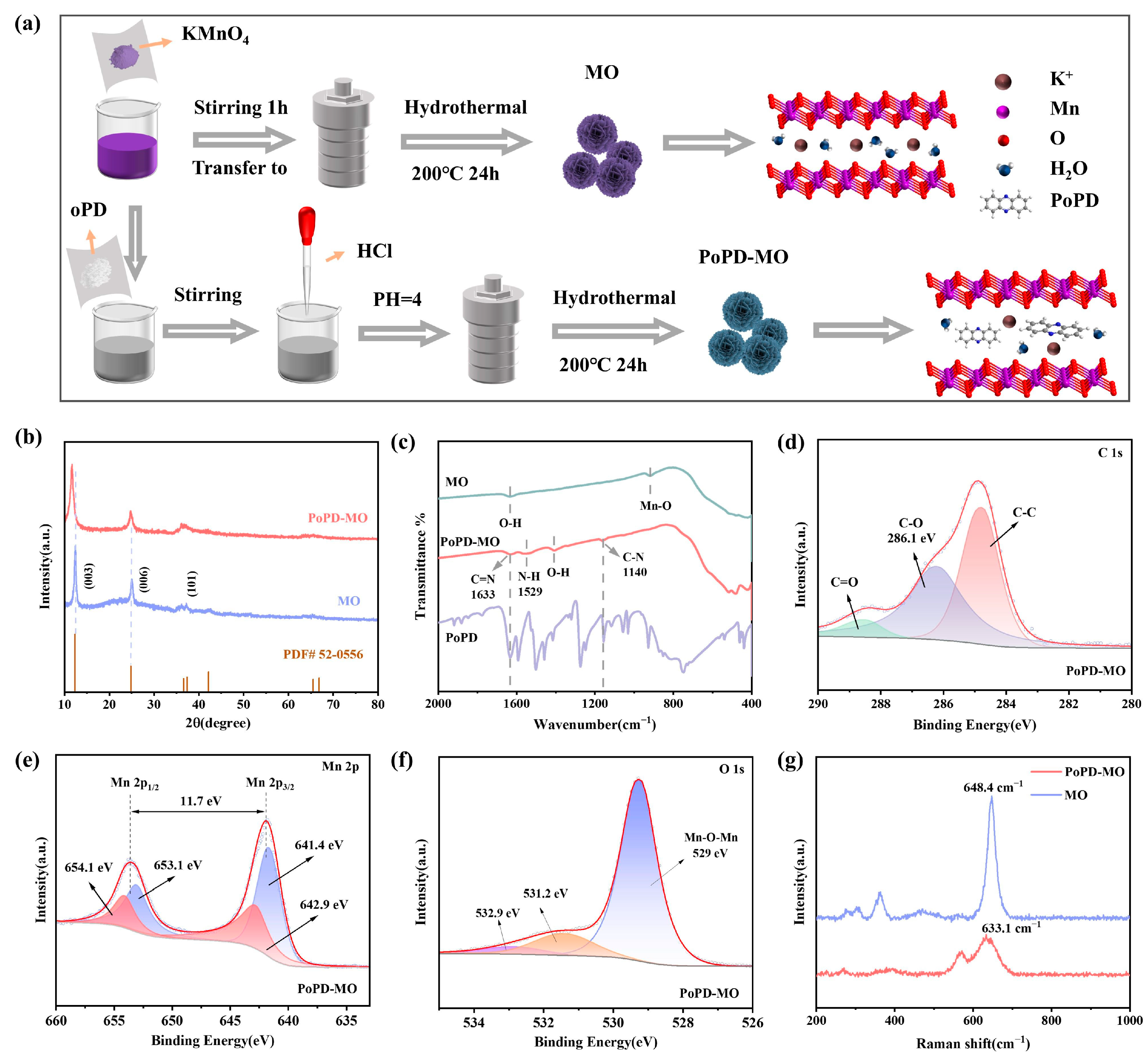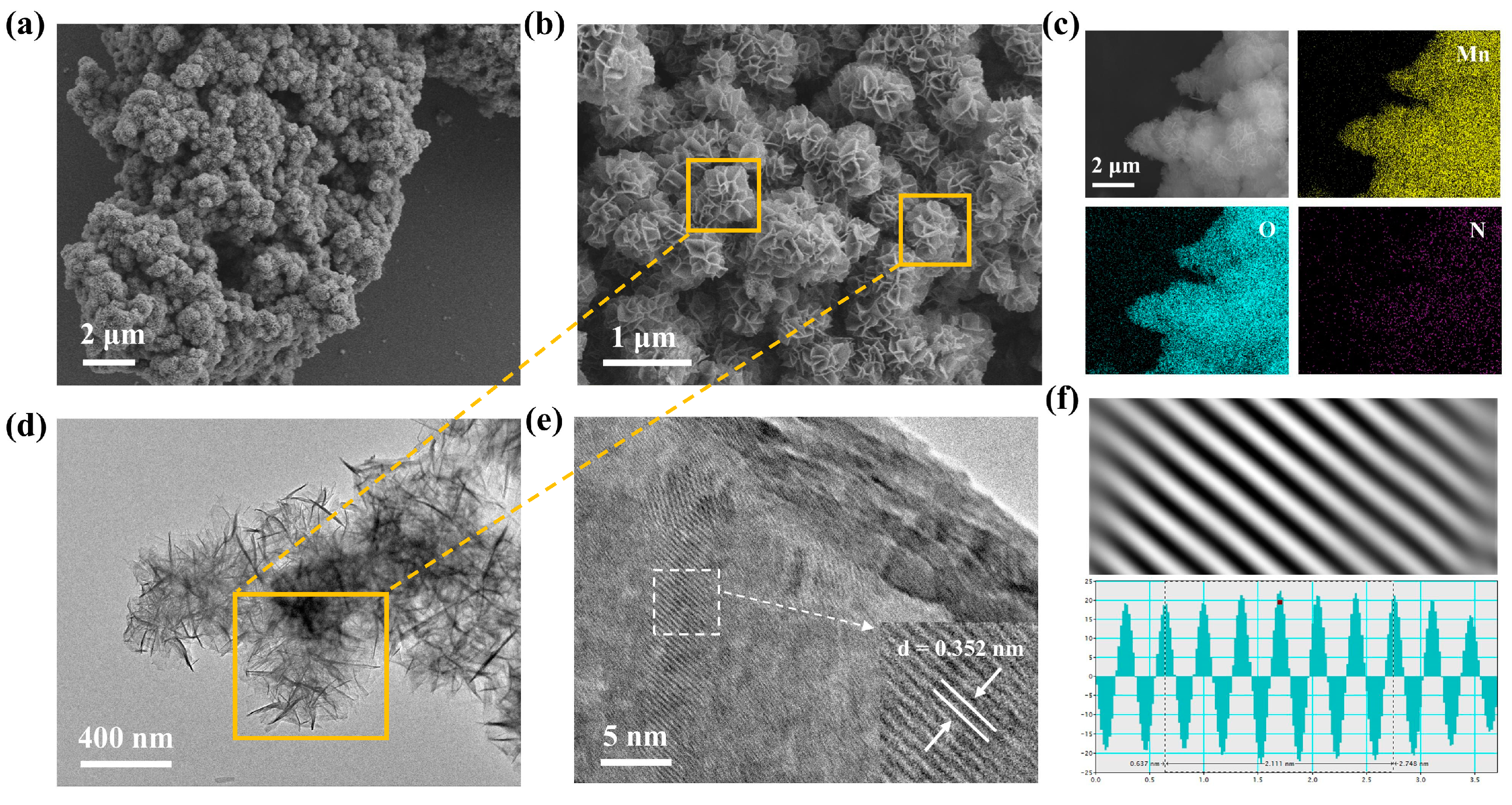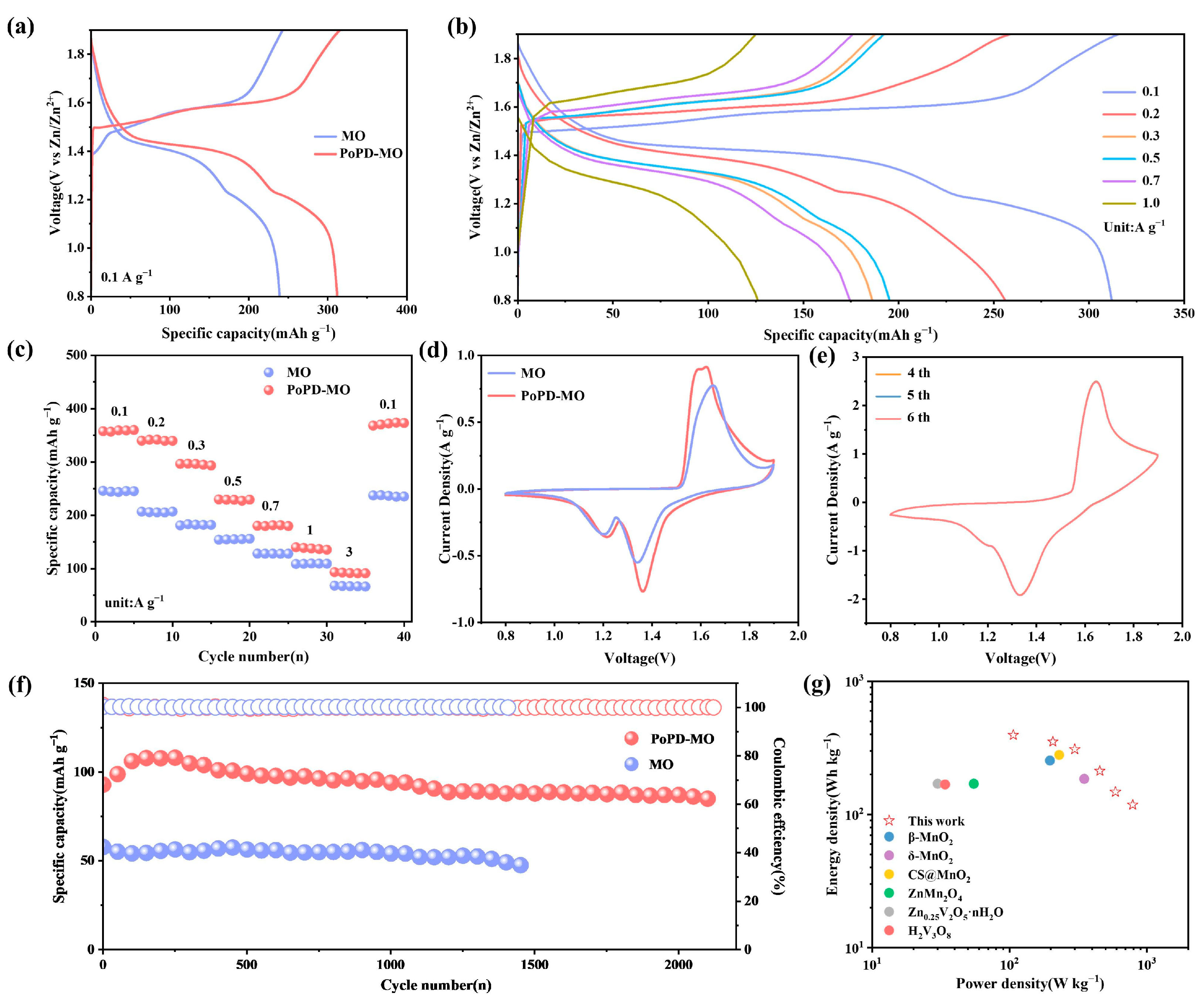Active Poly(o-phenylenediamine)-Intercalated Layered δ-MnO2 Cathode for High-Performance Aqueous Zinc-Ion Batteries
Abstract
1. Introduction
2. Results and Discussion
3. Conclusions
Supplementary Materials
Author Contributions
Funding
Institutional Review Board Statement
Data Availability Statement
Conflicts of Interest
References
- Xu, J.-W.; Gao, Q.-L.; Xia, Y.-M.; Lin, X.-S.; Liu, W.-L.; Ren, M.-M.; Kong, F.-G.; Wang, S.-J.; Lin, C. High-Performance Reversible Aqueous Zinc-Ion Battery Based on Iron-Doped Alpha-Manganese Dioxide Coated by Polypyrrole. J. Colloid Interface Sci. 2021, 598, 419–429. [Google Scholar] [CrossRef] [PubMed]
- Liu, M.H.; Feng, X.Y.; Yin, B.S.; Li, J.Z.; Li, M.D.; Ding, Y.X.; Sun, Y.; Li, H.; Li, W.S.; Zhang, S.W.; et al. Regulation of Cobalt-Nickel-Based Compounds via Glucose-Induced Phase Transitions for Enhanced Performance in Zinc-Based Alkaline Batteries. Appl. Surf. Sci. 2025, 693, 162812. [Google Scholar] [CrossRef]
- Kim, H.; Hong, J.; Park, K.-Y.; Kim, H.; Kim, S.-W.; Kang, K. Aqueous Rechargeable Li and Na Ion Batteries. Chem. Rev. 2014, 11423, 11788–11827. [Google Scholar] [CrossRef] [PubMed]
- Feng, X.Y.; Zhang, S.W.; Li, J.Z.; Hu, Y.F.; Ge, R.Y.; Shi, Y.W.; Yao, Y.L.; Yin, B.S.; Ma, T.Y. Yttrium Doping Stabilizes the Structure of Ni3(NO3)2(OH)4 Cathodes for Application in Advanced Ni–Zn Batteries. Nanoscale 2024, 16, 16933–16941. [Google Scholar] [CrossRef]
- Li, M.D.; Ding, Y.X.; Zhang, S.W.; Liu, M.H.; Sun, Y.; Zhang, Y.S.; Yin, B.S.; Ma, T.Y. Trace Cs Induced Phase Transition of Mn2O3 for Enhanced Magnesium Ion Capacitors. J. Mater. Chem. A 2024, 12, 10269–10278. [Google Scholar] [CrossRef]
- Dhir, S.; Wheeler, S.; Capone, I.; Pasta, M. Outlook on K-Ion Batteries. Chem 2020, 610, 2442–2460. [Google Scholar] [CrossRef]
- Ye, H.; Zeng, X.; Li, X.; He, K.; Li, Y.; Yuan, Y. Review of Ion Doping and Intercalation Strategies for Advancing Manganese-Based Oxide Cathodes in Aqueous Zinc-Ion Batteries. Nano Energy 2025, 136, 110740. [Google Scholar] [CrossRef]
- Shi, Y.W.; Yin, B.S.; Sun, Y.; Ge, R.Y.; Hu, Y.F.; Li, J.Z.; Li, H.; Zhang, S.W.; Ma, T.Y. Mg Ions Intercalated with V3O7 H2O to Construct Ultrastable Cathode Materials for Aqueous Zinc-Ion Batteries. Chem. Commun. 2024, 60, 8597–8600. [Google Scholar] [CrossRef]
- Li, K.; Li, R.; Guan, T.; Wang, L.; Xie, L.; Han, Q.; Qiu, X.; Cao, X.; Zhu, L. Recent Advancements in Cation-Intercalated Vanadium Oxide Cathode Materials for Zinc-Ion Batteries. Chem. Eng. J. 2025, 507, 159891. [Google Scholar] [CrossRef]
- Song, Y.; Jing, L.; Wang, R.; Cui, J.; Li, M.; Zhang, Y. Vanadium Oxide Nanospheres Encapsulated in N-Doped Carbon Nanofibers with Morphology and Defect Dual-Engineering toward Advanced Aqueous Zinc-Ion Batteries. J. Energy Chem. 2024, 89, 599–609. [Google Scholar] [CrossRef]
- Panda, P.K.; Huang, H.-Y.; Dash, P.; Hsieh, C.-T.; Chang, J.-K.; Liu, W.-R. Liquid-Phase Microwave Synthesis of Platinum-Based High-Entropy Alloy Catalysts on Carbon Supports for Electrochemical Hydrogen Adsorption/Desorption and Oxygen Evolution/Reduction Reactions. Int. J. Hydrogen Energy 2025, 111, 536–545. [Google Scholar] [CrossRef]
- Hu, Y.F.; Zhang, S.W.; Ren, Y.J.; Ge, R.Y.; Shi, Y.W.; Feng, X.Y.; Li, H.; Jia, B.H.; Yin, B.S.; Ma, T.Y. Lithium Doping Enhances the Aqueous Zinc Ion Storage Performance of V3O7 ⋅H2O Nanorods. ChemElectroChem 2024, 22, e202400504. [Google Scholar] [CrossRef]
- Liu, Y.; Sun, Y.; Zhang, J.; Hao, X.; Zhang, M.; Wei, P.; Zhao, X.; Cai, K. Electrochemically Inducing V2O5·nH2O Nanoarrays Vertically Growth on VSx Microrods for Highly Stable Zinc Ion Battery Cathode. Nano Energy 2024, 120, 109152. [Google Scholar] [CrossRef]
- Xu, W.; Ru, Q.; Pan, Z.; Zheng, M.; Wu, J.; Zhao, X.; Chen, F.; Zhang, J.; Ling, F.C.-C. Finely Crafted Lanthanum Vanadium Oxide Cathode as Durable and Flexible Quasi-Solid State Zinc Ion Battery. J. Mater. Sci. Mater. Electron. 2022, 338, 5635–5647. [Google Scholar] [CrossRef]
- Wen, X.-Y.; Li, W.; Chen, H.; Zhou, W.; Xiang, K.-X. Zn3V3O8 Nanorods with Outstanding Electrochemical Kinetics as Novel Anode for Aqueous Ammonium-Ion Batteries. Rare Met. 2025, 43, 03227-1. [Google Scholar] [CrossRef]
- Meng, F.B.; Ren, Y.J.; Ping, B.; Huang, J.; Li, P.; Chen, X.H.; Wang, N.; Li, H.; Zhang, L.; Zhang, S.W.; et al. Five-Axis Curved-Surface Multi-Material Printing on Conformal Surface to Construct Aqueous Zinc-Ion Battery Modules. Adv. Mater. 2024, 45, 2408475. [Google Scholar] [CrossRef]
- Sun, Y.; Liu, Y.; Wang, Z.; Zhao, X.; Cai, K. Self-Supporting Oxygen Vacancy-Rich α-MnO2 Nanowire/Few-Layer Graphite/SWNT Bundle Composite Film for High-Performance Flexible Aqueous Zinc-Ion Battery Cathode. Chem. Eng. J. 2024, 484, 149573. [Google Scholar] [CrossRef]
- Lin, T.-W.; Kumar, M.S.; Shen, H.-H.; Lin, J.-Y. Acetamide-Based Deep Eutectic Solvents as Efficient Electrolytes for K–MnHCFe//Zn Dual-Ion Batteries. J. Power Sources 2024, 614, 234972. [Google Scholar] [CrossRef]
- Zhang, N.; Cheng, F.; Liu, Y.; Zhao, Q.; Lei, K.; Chen, C.; Liu, X.; Chen, J. Cation-Deficient Spinel ZnMn2O4 Cathode in Zn(CF3SO3)2 Electrolyte for Rechargeable Aqueous Zn-Ion Battery. J. Am. Chem. Soc. 2016, 13839, 12894–12901. [Google Scholar] [CrossRef]
- Ding, X.; Wen, Y.; Qing, C.; Wei, Y.; Wang, P.; Liu, J.; Peng, Z.; Song, Y.; Chen, H.; Rong, Q. Cr-Induced Enhancement of Structural Stability in δ-MnO2 for Aqueous Zn-Ion Batteries. J. Alloys Compd. 2024, 986, 174041. [Google Scholar] [CrossRef]
- Xie, Q.; Cheng, G.; Xue, T.; Huang, L.; Chen, S.; Sun, Y.; Sun, M.; Wang, H.; Yu, L. Alkali Ions Pre-Intercalation of δ-MnO2 Nanosheets for High-Capacity and Stable Zn-Ion Battery. Mater. Today Energy 2022, 24, 100934. [Google Scholar] [CrossRef]
- Zhao, Y.; Zhu, Y.; Zhang, X. Challenges and Perspectives for Manganese-Based Oxides for Advanced Aqueous Zinc-Ion Batteries. InfoMat 2020, 22, 237–260. [Google Scholar] [CrossRef]
- Subjalearndee, N.; He, N.; Cheng, H.; Tesatchabut, P.; Eiamlamai, P.; Limthongkul, P.; Intasanta, V.; Gao, W.; Zhang, X. Gamma(ɣ)-MnO2/rGO Fibered Cathode Fabrication from Wet Spinning and Dip Coating Techniques for Cable-Shaped Zn-Ion Batteries. Adv. Fiber Mater. 2022, 43, 457–474. [Google Scholar] [CrossRef]
- Shi, X.; Liu, X.; Wang, E.; Cao, X.; Yu, Y.; Cheng, X.; Lu, X. Boosting the Zn Ion Storage Ability of Amorphous MnO2 Via Surface Engineering and Valence Modulation. Carbon Neutralization 2023, 21, 28–36. [Google Scholar] [CrossRef]
- Yan, L.; Liu, B.; Hao, J.; Han, Y.; Zhu, C.; Liu, F.; Zou, X.; Zhou, Y.; Xiang, B. In-Situ Cation-Inserted MnO2 with Selective Accelerated Intercalation of Individual H+ or Zn2+ Ions in Aqueous Zinc Ion Batteries. J. Energy Chem. 2023, 82, 88–102. [Google Scholar] [CrossRef]
- Zhai, X.-Z.; Qu, J.; Hao, S.-M.; Jing, Y.-Q.; Chang, W.; Wang, J.; Li, W.; Abdelkrim, Y.; Yuan, H.; Yu, Z.-Z. Layered Birnessite Cathode with A Displacement/Intercalation Mechanism for High-Performance Aqueous Zinc-Ion Batteries. Nano-Micro Lett. 2020, 121, 56. [Google Scholar] [CrossRef]
- Chomkhuntod, P.; Sawangphruk, M. Understanding the Effect of Pre-Intercalated Cations on Zn-Ion Storage Mechanism of Layered Birnessite Manganese Oxide for Aqueous Zn-Ion Batteries. ECS Meet. Abstr. 2022, MA2022-011, 25. [Google Scholar] [CrossRef]
- Shang, Y.; Xu, Z.; Bao, Y.; Fu, C.; Mao, G.; Zhao, Y.; Yang, H.Y.; Shen, J. Inhibiting Lattice Distortion of Ultrahigh Nickel Co-Free Cathode Material for Lithium-Ion Batteries. Nano Lett. 2025, 255, 1845–1853. [Google Scholar] [CrossRef]
- Huang, J.; Wang, Z.; Hou, M.; Dong, X.; Liu, Y.; Wang, Y.; Xia, Y. Polyaniline-Intercalated Manganese Dioxide Nanolayers as a High-Performance Cathode Material for an Aqueous Zinc-Ion Battery. Nat. Commun. 2018, 91, 2906. [Google Scholar] [CrossRef]
- Shi, H.-Y.; Ye, Y.-J.; Liu, K.; Song, Y.; Sun, X. A Long-Cycle-Life Self-Doped Polyaniline Cathode for Rechargeable Aqueous Zinc Batteries. Angew. Chem. Int. Ed. 2018, 5750, 16359–16363. [Google Scholar] [CrossRef]
- Ghanbari, K.; Mousavi, M.F.; Shamsipur, M.; Karami, H. Synthesis of Polyaniline/Graphite Composite as A Cathode of Zn-Polyaniline Rechargeable Battery. J. Power Sources 2007, 1702, 513–519. [Google Scholar] [CrossRef]
- Zhang, S.; Long, S.; Li, H.; Xu, Q. A High-Capacity Organic Cathode Based On Active N Atoms for Aqueous Zinc-Ion Batteries. Chem. Eng. J. 2020, 400, 125898. [Google Scholar] [CrossRef]
- Zhang, F.; Du, M.; Miao, Z.; Li, H.; Dong, W.; Sang, Y.; Jiang, H.; Li, W.; Liu, H.; Wang, S. Oxygen Vacancies and N-doping in Organic–Inorganic Pre-Intercalated Vanadium Oxide for High-Performance Aqueous Zinc-Ion Batteries. InfoMat 2022, 411, e12346. [Google Scholar] [CrossRef]
- Naresh, N.; Eom, S.; Lee, S.J.; Jeong, S.H.; Jung, J.-W.; Jung, Y.H.; Kim, J.-H. Disordered Structure and Reversible Phase Transformation from K-Birnessite to Zn-Buserite Enable High-Performance Aqueous Zinc-Ion Batteries. Energy Environ. Mater. 2024, 73, e12640. [Google Scholar] [CrossRef]
- Li, M.; Liu, M.; Lu, Y.; Zhang, G.; Zhang, Y.; Li, Z.; Xu, Q.; Liu, H.; Wang, Y. A Dual Active Site Organic–Inorganic Poly(O-Phenylenediamine)/NH4V3O8 Composite Cathode Material for Aqueous Zinc-Ion Batteries. Adv. Funct. Mater. 2024, 3419, 2312789. [Google Scholar] [CrossRef]
- Li, H.; Zhou, S.; Chen, S. Highly Efficient Top-Emitting Quantum-Dot Light-Emitting Diodes with Record-Breaking External Quantum Efficiency of over 44.5%. Laser Photonics Rev. 2023, 178, 2300371. [Google Scholar] [CrossRef]
- Bláha, M.; Trchová, M.; Morávková, Z.; Humpolíček, P.; Stejskal, J. Semiconducting Materials from Oxidative Coupling of Phenylenediamines under Various Acidic Conditions. Mater. Chem. Phys. 2018, 205, 423–435. [Google Scholar] [CrossRef]
- He, Y.; Xu, H.; Shi, J.; Liu, P.; Tian, Z.; Dong, N.; Luo, K.; Zhou, X.; Liu, Z. Polydopamine Coating Layer Modified Current Collector for Dendrite-Free Li Metal Anode. Energy Storage Mater. 2019, 23, 418–426. [Google Scholar] [CrossRef]
- Zhang, A.; Yin, X.; Saadoune, I.; Wei, Y.; Wang, Y. Zwitterion Intercalated Manganese Dioxide Nanosheets as High-Performance Cathode Materials for Aqueous Zinc Ion Batteries. Small 2024, 2042, 2402811. [Google Scholar] [CrossRef]
- Xie, D.; Wang, Y.; Tian, L.; Huang, H.; Sun, J.; Kim, D.-W.; Zhao, J.; Mao, J. Dual-Functional Ca-Ion-Doped Layered δ-MnO2 Cathode for High-Performance Aqueous Zinc-Ion Batteries. Adv. Funct. Mater. 2025, 354, 2413993. [Google Scholar] [CrossRef]
- Hu, L.; Gao, R.; Zhang, A.; Yang, R.; Zang, X.; Wang, S.; Yao, S.; Yang, Z.; Hao, H.; Yan, Y.-M. Cu2+ Intercalation Activates Bulk Redox Reactions of MnO2 for Enhancing Capacitive Performance. Nano Energy 2020, 74, 104891. [Google Scholar] [CrossRef]
- Guan, C.; Liu, X.; Ren, W.; Li, X.; Cheng, C.; Wang, J. Rational Design of Metal-Organic Framework Derived Hollow NiCo2O4 Arrays for Flexible Supercapacitor and Electrocatalysis. Adv. Energy Mater. 2017, 712, 1602391. [Google Scholar] [CrossRef]
- Zhang, Y.; Deng, S.; Pan, G.; Zhang, H.; Liu, B.; Wang, X.-L.; Zheng, X.; Liu, Q.; Wang, X.; Xia, X.; et al. Introducing Oxygen Defects into Phosphate Ions Intercalated Manganese Dioxide/Vertical Multilayer Graphene Arrays to Boost Flexible Zinc Ion Storage. Small Methods 2020, 46, 1900828. [Google Scholar] [CrossRef]
- Wang, T.; Jin, J.; Zhao, X.; Qu, X.; Jiao, L.; Liu, Y. Unraveling the Anionic Redox Chemistry in Aqueous Zinc-MnO2 Batteries. Angew. Chem. Int. Ed. 2024, 6347, e202412057. [Google Scholar] [CrossRef]
- Ma, Y.; Xu, M.; Liu, R.; Xiao, H.; Liu, Y.; Wang, X.; Huang, Y.; Yuan, G. Molecular Tailoring of MnO2 by Bismuth Doping to Achieve Aqueous Zinc-Ion Battery with Capacitor-Level Durability. Energy Storage Mater. 2022, 48, 212–222. [Google Scholar] [CrossRef]
- Xia, J.; Zhou, Y.; Zhang, J.; Lu, T.; Gong, W.; Zhang, D.; Wang, X.; Di, J. Triggering High Capacity and Superior Reversibility of Manganese Oxides Cathode via Magnesium Modulation for Zn//MnO2 Batteries. Small 2023, 1937, 2301906. [Google Scholar] [CrossRef] [PubMed]
- Xu, Y.; Zhang, G.; Wang, X.; Zhang, J.; Wen, H.; Wang, D.; Yuan, Y.; Jiang, Q.; Qian, H.; Xi, Y.; et al. Efficient Modulation d/p-Band Center Proximity in Birnessite-Type MnO2 by Cation/Anion Co-Doping for Enhanced Dual-Ion Storage. Adv. Funct. Mater. 2025, 2500137. [Google Scholar] [CrossRef]
- Liu, S.; Zhu, H.; Zhang, B.; Li, G.; Zhu, H.; Ren, Y.; Geng, H.; Yang, Y.; Liu, Q.; Li, C.C. Tuning the Kinetics of Zinc-Ion Insertion/Extraction in V2O5 by In Situ Polyaniline Intercalation Enables Improved Aqueous Zinc-Ion Storage Performance. Adv. Mater. 2020, 3226, 2001113. [Google Scholar] [CrossRef] [PubMed]
- Qin, L.; Zhu, Q.; Li, L.; Cheng, H.; Li, W.; Fang, Z.; Mo, M.; Chen, S. Ni2+-Doped ZnMn2O4 with Enhanced Electrochemical Performance as Cathode Material for Aqueous Zinc-Ion Batteries. J. Solid State Electrochem. 2023, 273, 773–784. [Google Scholar] [CrossRef]
- Zhao, C.; Wang, Y.; Li, Z.; Chen, W.; Xu, Q.; He, D.; Xi, D.; Zhang, Q.; Yuan, T.; Qu, Y.; et al. Solid-Diffusion Synthesis of Single-Atom Catalysts Directly from Bulk Metal for Efficient CO2 Reduction. Joule 2019, 32, 584–594. [Google Scholar] [CrossRef]
- Wang, K.; Li, S.; Chen, X.; Shen, J.; Zhao, H.; Bai, Y. Trifunctional Rb+-Intercalation Enhancing the Electrochemical Cyclability of Ammonium Vanadate Cathode for Aqueous Zinc Ion Batteries. ACS Nano 2024, 189, 7311–7323. [Google Scholar] [CrossRef]
- Yu, B.; Lu, L.; He, Y.; Dai, X.; Wang, Y.; Wang, T.; Chong, S.; Liu, L.; Liu, Y.; Tan, Q. Hierarchical Porous CS@Ce-MnO2 as Cathode for Energy-Dense and Long-Cycling Flexible Aqueous Zinc-Ion Batteries. J. Colloid Interface Sci. 2024, 654, 56–65. [Google Scholar] [CrossRef] [PubMed]
- Zhang, N.; Cheng, F.; Liu, J.; Wang, L.; Long, X.; Liu, X.; Li, F.; Chen, J. Rechargeable Aqueous Zinc-Manganese Dioxide Batteries with High Energy and Power Densities. Nat. Commun. 2017, 81, 405. [Google Scholar] [CrossRef]
- Kamenskii, M.A.; Volkov, F.S.; Eliseeva, S.N.; Holze, R.; Kondratiev, V.V. Comparative Study of PEDOT- and PEDOT: PSS Modified δ-MnO2 Cathodes for Aqueous Zinc Batteries with Enhanced Properties. J. Electrochem. Soc. 2023, 1701, 010505. [Google Scholar] [CrossRef]
- Kundu, D.; Adams, B.D.; Duffort, V.; Vajargah, S.H.; Nazar, L.F. A High-Capacity and Long-Life Aqueous Rechargeable Zinc Battery Using a Metal Oxide Intercalation Cathode. Nat. Energy 2016, 110, 16119. [Google Scholar] [CrossRef]
- Pang, Q.; Sun, C.; Yu, Y.; Zhao, K.; Zhang, Z.; Voyles, P.M.; Chen, G.; Wei, Y.; Wang, X. H2V3O8 Nanowire/Graphene Electrodes for Aqueous Rechargeable Zinc Ion Batteries with High Rate Capability and Large Capacity. Adv. Energy Mater. 2018, 819, 1800144. [Google Scholar] [CrossRef]
- Yang, L.; Zhang, J.; Zhou, X.; Liu, Y. Amorphous Aluminum-Doped Manganese Oxide Cathode with Strengthened Performance for Aqueous Zinc-Ion Batteries. J. Alloys Compd. 2025, 1012, 178502. [Google Scholar] [CrossRef]
- Song, Y.; Li, J.; Qiao, R.; Dai, X.; Jing, W.; Song, J.; Chen, Y.; Guo, S.; Sun, J.; Tan, Q.; et al. Binder-Free Flexible Zinc-Ion Batteries: One-Step Potentiostatic Electrodeposition Strategy Derived Ce Doped-MnO2 Cathode. Chem. Eng. J. 2022, 431, 133387. [Google Scholar] [CrossRef]
- Wang, L.; Wang, X.; Song, B.; Wang, Z.; Zhang, L.; Lu, Q. Facile in Situ Synthesis of PEDOT Conductor Interface at the Surface of MnO2 Cathodes for Enhanced Aqueous Zinc-Ion Batteries. Surf. Interfaces 2022, 33, 102222. [Google Scholar] [CrossRef]
- Wang, Z.; Han, K.; Wan, Q.; Fang, Y.; Qu, X.; Li, P. Mo-Pre-Intercalated MnO2 Cathode with Highly Stable Layered Structure and Expanded Interlayer Spacing for Aqueous Zn-Ion Batteries. ACS Appl. Mater. Interfaces 2023, 151, 859–869. [Google Scholar] [CrossRef]




Disclaimer/Publisher’s Note: The statements, opinions and data contained in all publications are solely those of the individual author(s) and contributor(s) and not of MDPI and/or the editor(s). MDPI and/or the editor(s) disclaim responsibility for any injury to people or property resulting from any ideas, methods, instructions or products referred to in the content. |
© 2025 by the authors. Licensee MDPI, Basel, Switzerland. This article is an open access article distributed under the terms and conditions of the Creative Commons Attribution (CC BY) license (https://creativecommons.org/licenses/by/4.0/).
Share and Cite
Yuan, Z.; Yin, B.; Mi, W.; Liu, M.; Zhang, S. Active Poly(o-phenylenediamine)-Intercalated Layered δ-MnO2 Cathode for High-Performance Aqueous Zinc-Ion Batteries. Polymers 2025, 17, 1003. https://doi.org/10.3390/polym17081003
Yuan Z, Yin B, Mi W, Liu M, Zhang S. Active Poly(o-phenylenediamine)-Intercalated Layered δ-MnO2 Cathode for High-Performance Aqueous Zinc-Ion Batteries. Polymers. 2025; 17(8):1003. https://doi.org/10.3390/polym17081003
Chicago/Turabian StyleYuan, Ziqian, Bosi Yin, Wenhui Mi, Minghui Liu, and Siwen Zhang. 2025. "Active Poly(o-phenylenediamine)-Intercalated Layered δ-MnO2 Cathode for High-Performance Aqueous Zinc-Ion Batteries" Polymers 17, no. 8: 1003. https://doi.org/10.3390/polym17081003
APA StyleYuan, Z., Yin, B., Mi, W., Liu, M., & Zhang, S. (2025). Active Poly(o-phenylenediamine)-Intercalated Layered δ-MnO2 Cathode for High-Performance Aqueous Zinc-Ion Batteries. Polymers, 17(8), 1003. https://doi.org/10.3390/polym17081003





